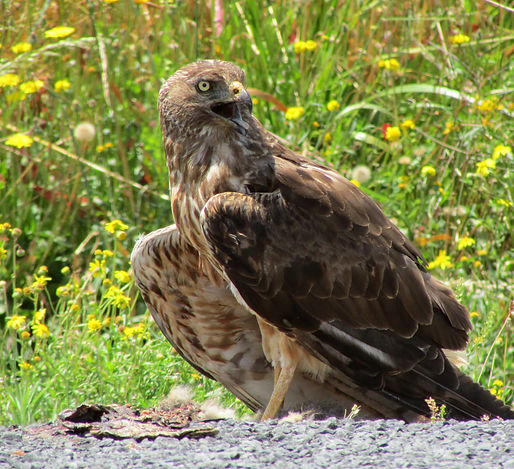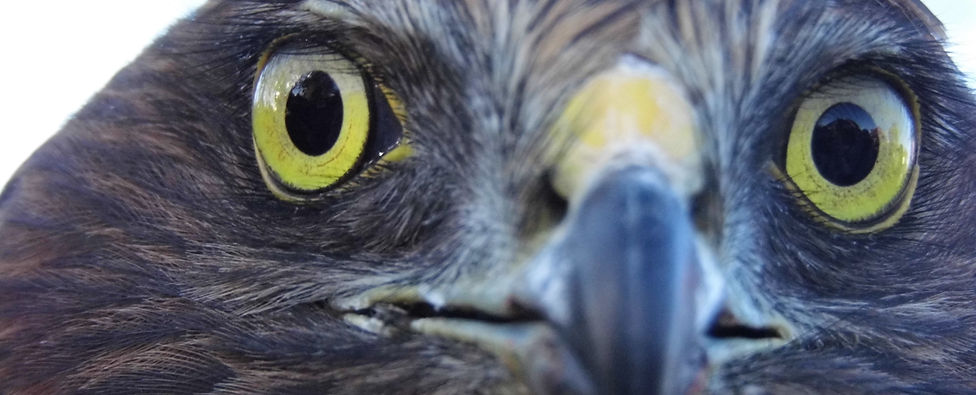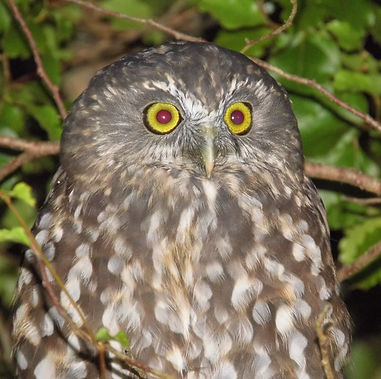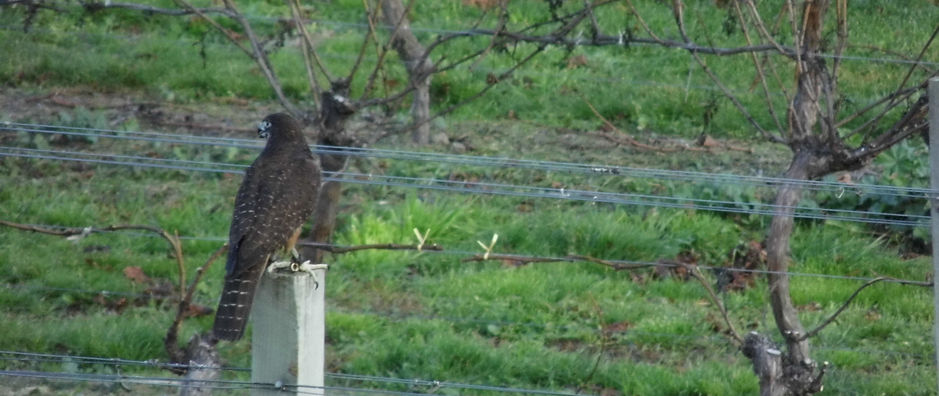

RAPTORS
The Birds of prey
So, what is a raptor?
Raptor is really just another name for a bird of prey. I guess it's also easier to say than, “Birds of Prey.”
A "Bird of Prey" is a bird that hunts for its food.
Many other birds are predatory but the term ‘bird of prey’ only refers to those that catch their prey with
their feet and have a hooked bill suitable for subduing prey and tearing flesh into edible chunks. The only
exceptions are those that only feed on carrion (e.g. vultures). They can also be defined by certain genes
Not needing to grapple their prey, those that solely feed on carrion only have the strongly hooked bill
suitable for tearing flesh.
The word “raptor” names many birds of prey, including falcons, hawks, owls and eagles.
Each of these species fulfils a unique role in our ecosystem making them vital to the maintenance of a
healthy New Zealand environment.
• The New Zealand Falcon specialises in chasing live prey.
• The Swamp Harrier is usually seen slowly quartering the landscape for food.
• The Morepork Owl feeds largely on insects within forested landscapes.
• The Barn Owl occurs in open farmland habitat.
Some birds are partly predatory, only occasionally attacking. The list below is of the partly predatory birds
and what they often attack/steal.
• Kea (Nestor notabilis), native mountain parrots, sometimes attack seabird chicks in their burrows.
• Weka (flightless rails, Gallirallus australis) take bird eggs and chicks from nests.
• So do blackbacked gulls (Larus dominicanus), skuas (Catharacta lonnbergi) and nonnative
magpies (Gymnorhina tibicen).
• The 18kilogram flightless Adzebill (Aptornis defosser and A. otidformis), now extinct, apparently
hunted other birds.
Part One -
Introducing Raptors

But the life of a raptor is not all happy days and hunting, there are dangers. For example, the great big green
and black things on the ground with bang sticks sometimes try to kill the birds.
Another threat to birds is also not enough food. This can happen a lot in winter.
Resting or perching on powerlines can be fatal for birds.
And, of course, there is the threat of introduced animals. Rats, hedgehogs, stoats, ferrets and cats were all
introduced, and are a threat to bird life here in New Zealand.
There are many more threats to birds that I could cover, but I will move on because there is a lot of information about raptors that is probably a little more interesting.
New Zealand birds of prey are included in the following taxonomic* families:
Falconidae: NZ Falcon
Strigidae: Morepork Owl
Tytonidae: Barn Owl
Accipitridae: Swamp Harrier, Kites (NZ vagrant raptor)
And now we look into each of the birds lives, personalities, foods...
I won't give too much away, because you'll read it all in the next sections.
*Read Amber Calman's Taxamony articles in the groups magazine starting issue "Bush Birds"
About
BIRDS
Swamp Harrier (Circus approximans)
Overview
The Swamp Harrier, also known as the kahu, harrier hawk or Australasian harrier, is a bird of the open country. It is often seen soaring and looking for prey, or eating dead rabbits or possums on the road.
The swamp harrier also occurs in Australia, New Guinea and many islands of the southern Pacific. In New Zealand harriers are found from the Kermadec Islands in the far north, to the Chatham Islands, and they occasionally stray as far as the chilly subantarctic islands.
Fossil records show that it came across the Tasman Sea from Australia, and became established in New Zealand less than 1,000 years ago. At that time Eyles’s harrier (Circus eylesi), four times larger, was also present.
At 850 grams, fully grown females are 200 grams heavier than males. Both sexes are the same length, about 55 centimetres.
The oldest known age for a harrier in New Zealand is 18 years.
Part two -
Australasian Harrier

Habitat and food;
Swamp harriers hunt in open country. After Europeans arrived in New Zealand and cleared land for
farming, the birds’ numbers increased. They catch small birds and mammals up to the size of rabbits, as well as lizards, frogs, fish and large insects. They also eat carrion, including road kill and dead lambs, and spend much time hunting for birds' nests. Since the 1950s, successful rabbit control has meant less food for harriers, and their numbers have fallen.
Aerial hunter;
When looking for food, harriers hold their large straight wings in a shallow V to soar on thermal winds,circling effortlessly until they dive for prey. In their courtship ritual, the male performs steep dives and loops, and the female turns on her back in mid-
air to greet him.
Breeding;
The breeding season starts in June, when males establish territories of several square kilometres. Females build nests in tall grasslike plants such as toetoe.
They usually lay three to five off white eggs between September and December. The male does not feed the chicks, but delivers food to his mate while both are flying. Chicks are able to leave the nest at 45 days.
Signs of age;
Maori knew older harriers as kahu korako, a reference to their pale feathers. As harriers grow older, they lose the dark plumage of youth, and some very old birds appear almost grey.
Hunting harriers;
Believing harriers posed a threat to introduced game birds such as partridges, pheasant and quail, Acclimatisation Societies offered a bounty until the 1940s. Hundreds of thousands were killed between 1860 and 1950. Naturalist Walter Buller reported that ‘upwards of a thousand’ were killed each year on one Canterbury sheep run – yet they remained abundant.

Part Three -
The Morepork
Morepork (Ninox novaeseelandiae)
Overview;
At dusk, the melancholy sound of the morepork can be heard in forests and parks as it calls to other moreporks and claims territory. Its European name (Morepork), Maori name (Ruru) and Australian name (Boobook) all echo its two part cry.
The morepork is New Zealand’s only surviving native owl. They are found in mainland New Zealand’s forests and on many offshore islands. They are less common in the drier, more open regions of Canterbury and Otago. Speckled dark brown, with yellow eyes and long tails, they are around 29 centimetres long from head to tail and 175 grams in weight. Another morepork subspecies lives on Norfolk Island. It was reduced in numbers to a single female, but after two males were introduced from New Zealand in 1987, a hybrid population was reestablished.
The larger laughing owl became extinct in the 20th century. The German or little owl is a smaller, introduced species.
Neighbourhood watch;
Birds such as robins, grey warblers and fantails can end up as prey for moreporks. During the day, these small birds sometimes mob drowsy moreporks and chasethem away from their roosts. Their noisy mobbing calls force the sleepy predators to search for a more
peaceful spot.
Habits;
During the day, moreporks sleep in roosts. By night they hunt a variety of animals – mainly large invertebrates including scarab and huhu beetles, moths and caterpillars, weta and spiders. They also take small birds, rats and mice. They can find suitable food in pine
forests as well as native forest.
Stealthy fliers;
Moreporks have soft fringes on the edge of their feathers, so they can fly almost silently and not alert potential prey. This also allows moreporks to hear the movements of their prey as they approach, rather than the noise of their own wings. They have acute
hearing and their large eyes are very sensitive to light.
Breeding;
Moreporks nest in tree hollows, in clumps of epiphytes (perching plants), or in cavities among rocks androots. The female lays up to three white eggs, usually between October and November, which she incubates for 20 to 30 days. During this time she rarely hunts,
and the male brings food to her. Once the chicks hatch she stays mainly on the nest until the young owls are fully feathered. They can fly at about 35 days.
Ungracious hosts;
Scientists trying to establish a population of rare shore plovers on Motuora Island in the Hauraki Gulf were mystified as to why only two birds survived out of 75 placed there. The culprits turned out to be five pairs of moreporks that ate or chased away the new arrivals.

New Zealand Falcon; Karearea (Falco novaeseelandiae)
Overview;
Swooping down on their prey at speeds of up to 200 kilometres per hour, New Zealand falcons are supreme aerial hunters.
The falcon (karearea, Falco novaeseelandiae) almost always takes live prey on the wing, catching it with sharp talons. The fearless bird will attack and kill animals larger than itself.
Habitat and distribution;
New Zealand falcons vary in size and colour according to their main habitat. The bush falcon (whose population is an estimated 650 pairs) isfound in the North Island and the west and northwest South Island. The South Island’s eastern falcon (3,150 pairs) is found in open country. It is larger, and paler in colour. The southern falcon (200 pairs) lives in coastal Fiordland and the Auckland Islands, and has more reddish
plumage. These population figures are from a 1978 study, but numbers have probably fallen since. The World Conservation Union classifies the falcon as a near-threatened species. It is threatened by introduced predators such as stoats, by changes in habitat, and by people who
shoot it illegally.
Hunting techniques;
New Zealand falcons are not big birds, so their hunting feats are all the more impressive. At 500 grams and 45 centimetres, the female is larger than the male (300 grams). Females can kill young rabbits or hares weighing up to 3 kilograms. Falcons also take large birds such as whitefaced herons, kereru (New Zealand pigeons), ducks and pheasants. They catch big insects such as grasshoppers and beetles.
Falcons’ wings are angled back like an arrow. An attacking falcon dives steeply, giving what ornithologist
Walter Buller described as a ‘shrill cry of terror’ when it seizes its victim. After it catches a bird, it takes it to a plucking post, and dislocates the bird’s neck using a special notched tooth that all falcons have. It then plucks the feathers and eats the entire bird.
Part Four -
The New Zealand Falcon

Courtship and breeding;
Food plays an important role in falcon courtship. The courtship starts in early spring, when the male chases the female and pretends to attack her. This is followed by aerial acrobatics. The bond is sealed when the male carries prey to the female. She chases him, and he offers her the food near their future nest site.
Between September and December the female lays up to four reddish brown eggs. Falcons nest in a simple scraped hollow on a sheltered cliff ledge, in an astelia epiphyte high in a tree, or on the ground under a log or bush. They fiercely defend the surrounding area, and may divebomb passersby.
Male and female both incubate the eggs, for 33–35 days in total. Juvenile falcons can fly at around 35 days and may be independent of their parents after three months.
Part 5 - Summary of Birds Of Prey
Birds of prey are birds that hunt other birds and small animals. New Zealand has only three resident native
birds of prey: the New Zealand falcon, the swamp harrier
and the morepork.
The New Zealand falcon (Falco novaeseelandiae) and the swamp harrier (Circus approximans) are both
daytime hunters. The morepork (Ninox novaeseelandiae)
is a nocturnal hunting owl.
Since humans arrived in New Zealand, between 1250 and 1300 AD, several birds of prey have become extinct. The moa-hunting Haast’s eagle (Aquila moorei) was the world’s largest eagle, and had claws like a tiger’s. The large Eyles’s harrier (Circus eylesi), the laughing owl (Sceloglaux albifacies) and the New Zealand Owlet-nightjar (Aegotheles novaezealandiae) are also extinct.
The German or little owl (Athene noctua) is not native. It was introduced early in the 20th century, and is common in eastern parts of the South Island and the Nelson region.
Characteristics
The morepork, laughing owl and little owl are members of the owl order (Strigiformes), while falcons are Falconiformes and eagles, and harriers are Accipitriformes.
The three groups are not closely related, but share certain features. All hunt mostly from the air. They have acute vision, which helps them find prey. Some also have sensitive directional hearing. They have talons and curved bills for seizing prey – other birds, small mammals, lizards, frogs, and insects.
Super size predator the Haast’s eagle, now extinct, was the world’s largest eagle. Weighing around 12 kilos, it preyed on big birds, including 200 kilo moa, and died out when these were hunted to extinction. Haast’s eagle had humble origins. Its closest relatives are among the world’s smallest eagles, including Australia’s little eagle (Aquila morphnoides), which weighs just 1 kilo.
by Esther Ball
age 13